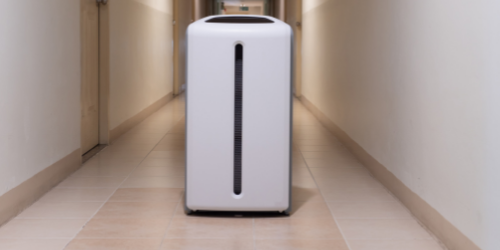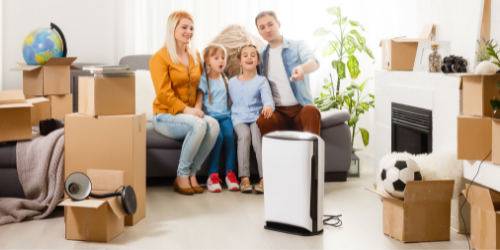How to tell if air purifier is working?
Get to know on how to check an air purifier.
When we use air purifiers at home, it can be a challenge to assess their performance. The dust particles that reduce air quality can be so microscopic that we can’t see them. Air purifiers may appear to be working, and it is not always clear if they are working as well as they should. Fortunately, there are a few tips that can tell you if your air purifier is working optimally.
How to Tell If an Air Purifier Is Working Properly [6 Easiest Ways To Check]

Here are six easy ways to check if your air purifier is working properly.
Airflow test
If you notice that there is no air blowing out from the vents even though the air purifier is on, it indicates poor air circulation. It is time to check the intake and outlet of the air purifier. There may be dust near the air intake. You can brush the dust away. You may also need to check if the fan is louder than normal, it means that the fan is working harder than it should, and the filter needs to be replaced.
The fan helps remove the pollutants by drawing in the air towards the filters to be trapped. Over time, these particles accumulate and clog the filters.
Indicator Lights
Air purifiers come with indicator lights that tell you when it is time to change the filter. Some units also have indicators to show fan speed, air quality, pollen mode, ion mode, etc.
If the filter service indicator light is on, it is possible that the filter has become clogged with dirt particles, and it needs to be cleaned or replaced. Generally, the filter life indicator has three settings – Green, Yellow, and Red.
If the indicator light is green, the unit is working properly. The yellow light warns you that it may soon be time to replace the filter. The red light is a clear indicator that you must replace the filter immediately.
Filters to be checked for pollutants
An air purifier is a high-efficiency appliance that removes airborne contaminants. It protects you from allergens, dust, bacteria, pet dander, and viruses and makes the indoor air clean and fresh.
Your air purifier may have activated charcoal technology, HEPA technology, Ozone, UV, or Negative Ion filters. Most air purifiers require you to clean or replace the pre-filter every 2-4 weeks for best performance. The pre-filter, i.e., the activated carbon filter, prevents odors and captures large airborne particles, VOCs (Volatile organic compounds), and pet dander that enters into the air purifier.
Some purifier filters will need to be replaced every 6-8 months. These filters include the True HEPA filter, the Medium filter, charcoal-based activated carbon filter, or customized filters, depending on the model.
Check air quality performance
You can do an air quality performance check, especially for pollen, odor, allergens, pollen, mold, and odor. The air quality check involves a particle test. Using an indoor air quality monitor, you can test the air quality in a room that doesn’t have an air purifier. Record the reading.
Then, bring the air purifier into the room and let it run for around 30 minutes. You can read the air quality monitor and record the new reading. The reading should be lower than the first time to prove that the air purifier is working properly. But, if the reading is higher, there is a problem with the air purifier, and you may need to get it checked.
Touch test
If the air purifier is not working well and the unit is working harder, you will notice that the unit is becoming hot to the touch. Once the filter is cleaned or replaced, and the air purifier is switched on again, you will see that the unit has cooled down considerably.
Professional testing of indoor air quality
If you are still unsure if the air purifier is working efficiently, you may need to seek professional assistance. Experts in making an accurate indoor air quality assessment will check the air purifier and help assess other concerns about air quality in and around your home.
What are the factors that affect the performance of an air purifier?
Factors that affect the performance of the air purifier include the size of the unit in relation to the room size, the filters, the location and age of the unit, and extreme weather conditions. Just like any other appliance, air purifiers need regular maintenance and upkeep.
You will also need to make sure that you place it in the right location so that there is nothing to block the air purifier’s airflow. It would be best to perform regular checks on the filters and follow the owner’s manual for a schedule on cleaning or replacing filters.
How to repair an air purifier?
Most problems that affect your air purifier occur because of poor maintenance. Some of the issues can be fixed at home easily. The first step is to identify the problem.
If the air purifier does not turn on, you must check the power cord and see if the unit is plugged into the right power outlet. You can try it in another power outlet to see if the problem is in the outlet or the cord. If the power cord is damaged, you will need to replace it.
If the air purifier has touch controls and is not responsive, the unit is likely not connected to the right power outlet, or the filter cover is placed incorrectly. It will help to follow the owner’s manual to place the filter cover according to instructions. On occasion, the power controls may be malfunctioning which will require professional assistance.
If the unit is making loud noises, check to see if the air filter is installed correctly or needs replacement. If some foreign object enters the unit, there could be a rattling sound. If you’re handy with tools, you may be able to remove the object without affecting the unit.
A simple fix for poor airflow is to remove all obstructions around the air purifier. Also, check if the fan is working correctly. If the fan speed is low, you may need to change the setting. You can press the fan speed control and adjust the setting in models that do not have an auto mode.
How to improve your indoor air quality naturally?

It is possible to improve indoor air quality naturally with a few tips.
Keep rugs/ carpets free of dust
Rugs and carpets can act as filters, too, and trap dust and other particles. Therefore, you must clean them weekly.
Control the humidity
Excess humidity can be a haven for mold and mildew. These trigger symptoms of allergies and make breathing difficult. There will be increased humidity in summer, so attempts to bring the moisture levels down will help. Ideally, consistent humidity levels can improve indoor air quality.
Indoor plants for fresh air
Plants can be considered natural air filters. Even a few indoor plants can make a huge difference to the air quality. Placing plants such as ferns, palm trees, and lilies that are known for their purifying properties can help draw out the pollutants.
Cooking vents
Kitchens produce smoke, carbon monoxide, and nitrogen dioxide from gas stoves, and electric burners also produce some at lower levels. Making sure that you turn on the vents or open a window when cooking would be a good step to take.
When should you call a professional?
When you install an air purifier in your home, it comes with a set of instructions on maintenance and service. While you can fix several small problems, there may be some that are beyond your capabilities. Malfunctioning touch controls are one, and broken components are another.
Similarly, there may be damages to the unit on the whole that professional technicians can only service.
More importantly, if you are the type that is not handy with appliances, you would be better off calling for professional support.
FAQ Section
1. How long do air purifiers take to work?
Air purifiers can take anywhere between 30 minutes and 2 hours to clean a room. To get a more accurate estimate, you must consider the room size, the model, dan speed, etc.
2. How do I know if your HEPA filter is dirty?
You will know that your HEPA filter is dirty if you open the unit and check. You will notice clumps of dirt, and the filter will appear more grey or black.
3. Do air purifiers work with open windows?
Air purifiers work best when the doors and windows are kept closed. Closed windows will ensure that clean air does not escape the room.
4. Can you use air purifier with fan?
The air purifier can be just as effective with or without a fan. It may take a little longer for the unit to clean the air in the room because fans may affect the airflow to the air purifier.
5. How do you measure dust in the air?
Dust particles are measured according to their size in microns. Dust measuring devices such as air sampling pumps can be useful to measure dust. Using a filter-based light-absorption photometer is also a device that can be used to measure dust.
The easiest way to check the dust level in your home is by using the indoor air quality monitor and taking a reading before and after switching on the air purifier.
6. How do I know if your air purifier is HEPA?
You will know if your air purifier is HEPA if you check the labeled score printed on the box. If it shows a 99.97% filtration efficiency, it is a True HEPA filter.
Wrapping Up
Having an air purifier to clean the indoor air is simple. Ensuring that it works efficiently so that you can breathe clean and fresh air throughout the day can be challenging. It requires monitoring the unit to see if it is working well.
And, it is imperative to keep the filters clean and the unit serviced on schedule.

About The Author
Olivia — a self-confessed air quality addict — is a home climate enthusiast, fresh air advocate, and someone with deep personal experience and knowledge about mold extermination. Her work was mentioned in countless notable humidity publications. Previously she was an editor at Mold Remediation.